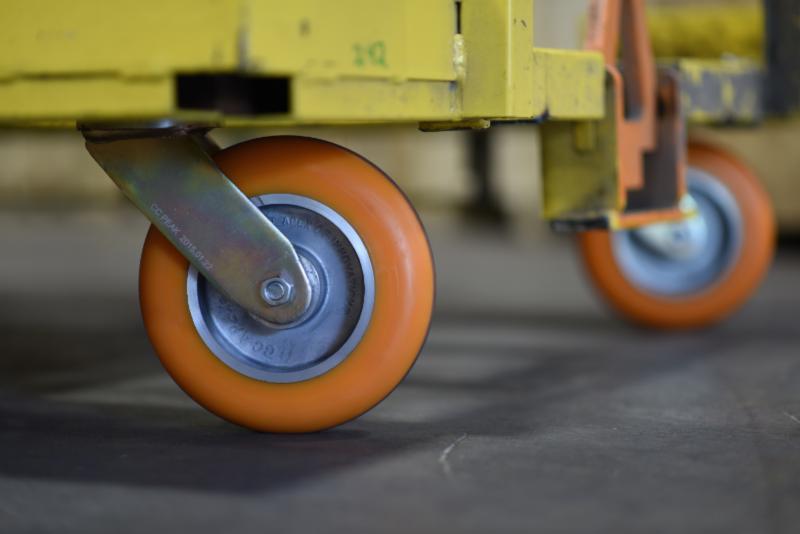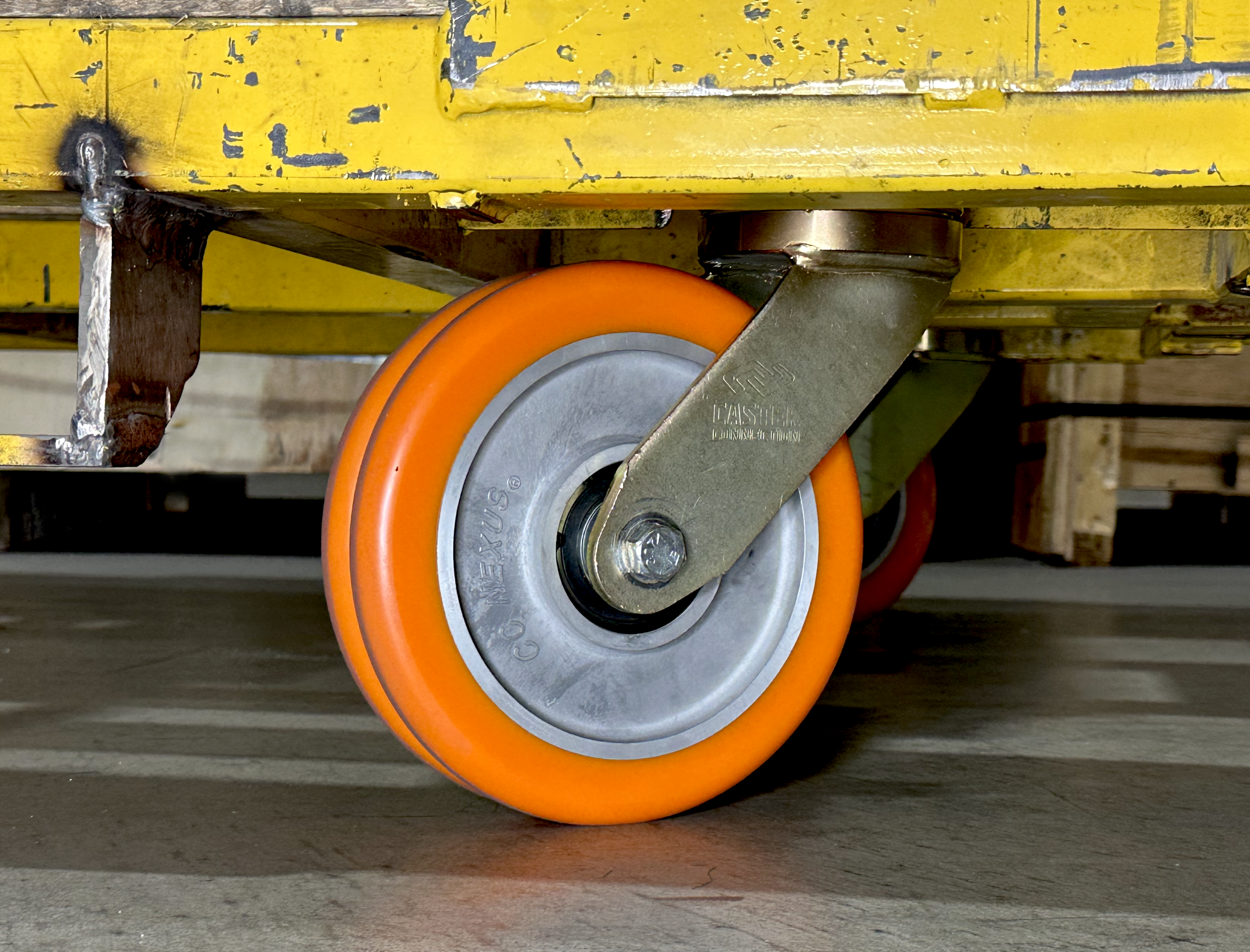The Connection Between Smart Material Handling Systems & Caster Performance

Automation is transforming the material handling landscape. From autonomous mobile robots (AMRs) to automated guided vehicles (AGVs) and collaborative robotics, smart material handling systems are creating faster, safer, and more efficient workflows. But while the spotlight often falls on sensors, software, and AI, there’s another component that plays a key role in the performance of these systems: casters.

The right caster solution supports automation by improving reliability, reducing resistance, and minimizing maintenance. In this blog, we’ll explore how the rise of robotics and automation is reshaping caster selection—and how the right choices can lower overhead and support long-term success.
Why Caster Design Matters in Automated Systems
Automation depends on consistency. Whether it’s an AGV navigating a warehouse or a robot-assisted cart delivering parts to an assembly line, every component needs to perform reliably—including the casters. Poor caster design can create friction, disrupt movement, and reduce the overall effectiveness of your system.

Smooth Travel
Casters must glide easily across a variety of floor types to keep automated systems running without interruption or drag.

Longer Battery Life
Reducing friction means less strain on motors and batteries, improving energy efficiency and extending equipment life.

Continuous Operation
Automation doesn’t take breaks. Casters need to withstand long duty cycles without overheating, degrading, or failing.

Accurate Tracking
Reliable directional stability is critical for AGVs, AMRs, and robot carts to follow precise routes and avoid errors or collisions.
Challenges of Caster Selection in Automated Material Handling
Caster selection plays a bigger role in automation than most people realize. When overlooked, it can become a hidden source of inefficiency, downtime, and maintenance issues. Automated systems demand more from every component, and casters are no exception.
1. Constant Motion and Higher Duty Cycles
Automated equipment runs longer and more frequently than manual systems. AGVs, AMRs, and robotic carts are often in near-continuous operation. Casters in these environments must be built for high endurance, capable of handling the strain of long shifts, heavy loads, and constant movement without premature wear or failure.

2. Demands for Navigation Precision
Automated systems depend on accurate, repeatable tracking. If a caster doesn’t maintain directional stability, it can throw off navigation paths, cause minor misalignments, or trigger full system errors. Precision caster tracking helps AGVs and other robotic platforms stay on course, improving overall system efficiency.

3. Vibration and Shock Control
Many smart material handling systems transport sensitive equipment or delicate payloads. Without proper shock absorption, vibration from the floor or the caster itself can damage electronics, disrupt sensors, or lead to premature failure of high-value goods. The right caster helps minimize that risk through vibration-dampening materials and construction.

4. Low Tolerance for Maintenance
One of the key benefits of automation is reducing manual intervention. Casters that require constant lubrication or frequent replacement defeat that purpose. Maintenance-free caster designs with sealed bearings and long-wearing components help support the autonomy and efficiency that automation systems are built to deliver.

How Caster Connection Supports Smarter Automation
Every automation system is only as strong as its weakest component. At Caster Connection, we help ensure your casters aren’t the bottleneck. We work directly with engineers, integrators, and facility managers to deliver caster solutions that align with the speed, precision, and reliability your smart systems demand.
Sealed Precision Bearings

Our casters are equipped with sealed bearings to deliver low-resistance, quiet performance—essential for autonomous vehicles and robot-driven systems. These components reduce rolling resistance and improve long-term consistency, even under continuous use.
High-Quality Polyurethane Treads

We use advanced polyurethane formulations designed to reduce noise, absorb vibration, and protect sensitive loads. These treads help maintain smooth operation across varied surfaces and contribute to better system stability.
Low-Profile, High-Capacity Designs

Space and balance matter in automation. Our compact caster rigs provide high load capacities while maintaining a low center of gravity, which helps with both maneuverability and equipment stability in motion.
Maintenance-Free Construction

Automation thrives on uptime. That’s why we offer maintenance-free casters that eliminate the need for regular lubrication or servicing. The result is fewer interruptions and a lower total cost of ownership.
Whether you're expanding a robotic fleet, upgrading tow carts, or retrofitting manual systems for automation, we can help you match the right caster to your application—ensuring your systems move as intelligently as they operate.
Smart Mobility That Scales With You

Investing in high-performance casters isn’t just about fixing a short-term problem. It’s a forward-thinking decision that can shape the trajectory of your operation. With the right caster solution, you gain more than better rolling performance—you increase system uptime, reduce energy consumption, and improve overall reliability.
Casters that are engineered for smart systems also support long-term scalability. They enable smoother handoffs between robots and operators, contribute to more predictable workflows, and reduce wear on facility infrastructure. This means fewer interruptions, fewer replacements, and a lower total cost of ownership over time.
Real-World Results: Optimizing a Robotics-Driven Workflow

A tech-forward distribution center deployed a fleet of AMRs to handle order picking and restocking. Initial caster choices on their payload carts created excessive drag, increasing battery usage and slowing movement. After partnering with Caster Connection, they upgraded to low-resistance, polyurethane casters with sealed bearings.
The Results
- 30% reduction in AMR energy consumption
- Improved navigation accuracy and tracking
- Extended caster life, reducing maintenance calls by 70%
Smarter Systems Deserve Smarter Casters

In a world where automation drives efficiency, every component has to pull its weight—and casters are no exception. They may not be the most visible part of your system, but they’re foundational to its success. Choosing the right caster solution can unlock new levels of performance, reduce operational overhead, and future-proof your automation investment.
If you're planning to upgrade your workflow or troubleshoot recurring caster issues, now is the time to get expert insight. Our team can perform a Caster Needs Evaluation to identify gaps and recommend better-fit solutions. Whether you’re looking to reduce downtime, improve energy efficiency, or align with automation best practices, we’ll help you select casters that support those goals.
Ready to take the next step? Explore automation-ready casters or talk to a specialist about your specific needs.
